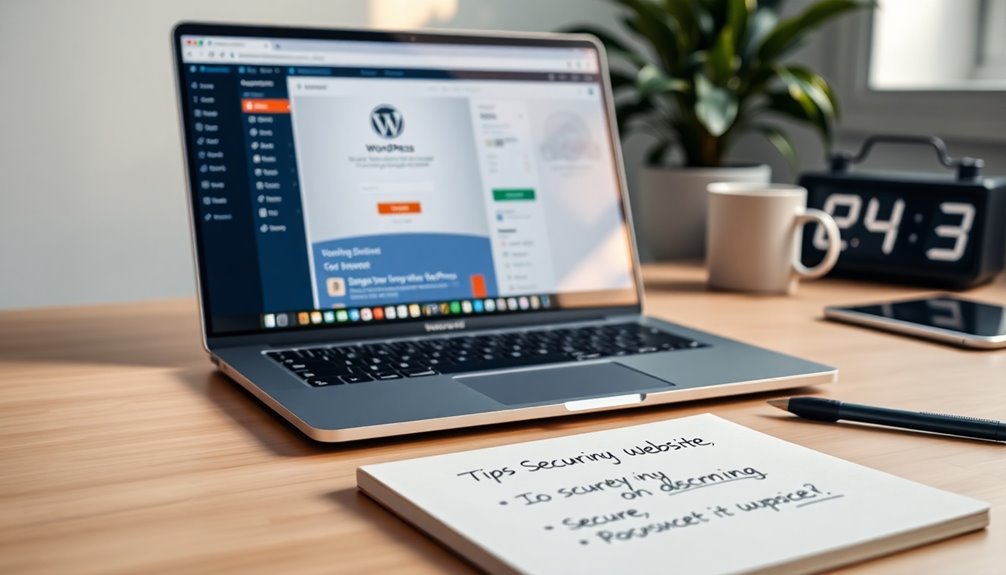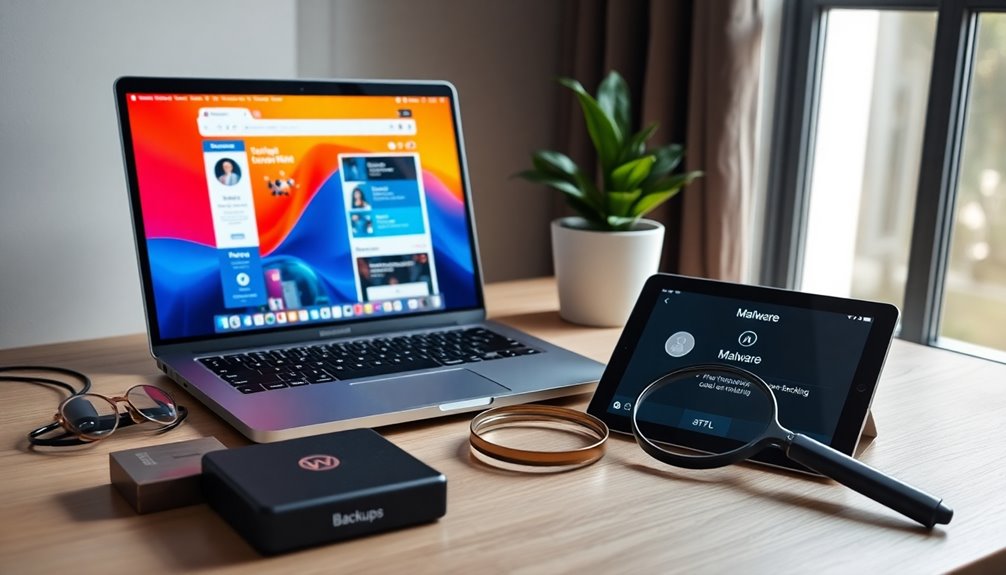To secure your WordPress site in 2024, keep your core, themes, and plugins updated. Use strong passwords and enable two-factor authentication for extra protection. Limit login attempts and change the default login URL to combat unauthorized access. Install an SSL certificate for HTTPS encryption, and schedule regular backups and malware scans to protect your data. Finally, disable file editing and secure your wp-config.php. Continue exploring these tips to enhance your site's security further.
Keep Your WordPress Core, Themes, and Plugins Updated
To keep your WordPress site secure, you need to stay on top of updates for the core, themes, and plugins. Outdated software can lead to security issues, making your site vulnerable to hackers. Regular updates not only enhance security but also improve website performance and compatibility with new features. Make it a habit to check your dashboard for available updates frequently. Additionally, using a reliable security plugin can help automate the update process and provide essential protections against threats.
Implementing regular updates is crucial, as they address vulnerabilities that hackers often exploit. You can also configure plugins to update automatically, ensuring you always have the latest security patches. Updating your WordPress core is essential, as developers release updates to fix flaws. Additionally, poorly coded themes and plugins can introduce security flaws, so it's crucial to verify the source of your plugins.
Following these WordPress security best practices will greatly reduce risks and help keep your site secure, allowing you to focus on creating great content without worry.
Implement Strong Passwords and Two-Factor Authentication
To keep your WordPress site secure, you need to implement strong passwords and two-factor authentication.
Strong passwords that mix letters, numbers, and symbols greatly lower the risk of unauthorized access, while regular updates help maintain that security. Additionally, strong password policies combined with two-factor authentication create a robust defense against unauthorized access. Investing in security plugins can further enhance your site's defenses, ensuring that even with strong passwords, you have an additional layer of protection.
With two-factor authentication in place, even if your password is compromised, a second verification step guarantees your account stays protected. Additionally, multi-factor authentication significantly reduces the risk of unauthorized access, even if one factor is compromised.
Password Strength Importance
In today's digital landscape, safeguarding your WordPress site with strong passwords and two-factor authentication (2FA) is essential.
Strong passwords should be at least 12 characters long, mixing uppercase letters, lowercase letters, numbers, and special characters to defend against brute force attacks. A password manager can help you create and store complex passwords, reducing the temptation to reuse weak login credentials.
Implementing 2FA adds another layer of account security, requiring a second verification method, like a temporary code sent to your mobile device. This security solution can block up to 99.9% of automated attacks, making unauthorized access far more difficult.
Regular Password Updates
Strong passwords and two-factor authentication lay the groundwork for your WordPress security, but regular password updates are just as important. Changing your passwords every 3-6 months helps protect against unauthorized access, especially if you've had any compromised credentials.
Use password managers like 1Password or LastPass to create and manage unique passwords for each account, ensuring that your login security remains robust. Remember, strong passwords should mix uppercase letters, lowercase letters, numbers, and special characters.
By regularly updating these passwords, you enhance your WordPress admin protection and minimize the risks associated with stale passwords. Combined with two-factor authentication, you're taking significant steps toward securing your site against potential threats.
Prioritize these practices for a safer online presence.
Two-Factor Authentication Benefits
How can two-factor authentication (2FA) transform your WordPress security? By adding an extra layer, 2FA requires a temporary code in addition to your strong password during login.
This greatly reduces unauthorized access risks, as hackers need both pieces to breach your account. In fact, accounts with 2FA enabled are 99.9% less likely to be compromised.
Integrating solutions like WP2FA or Google Authenticator into your WordPress sites is straightforward and doesn't require extensive technical knowledge.
Regularly using strong passwords alongside 2FA further fortifies your account security, addressing common vulnerabilities found in online platforms.
Don't leave your site exposed—embrace the benefits of Two-Factor Authentication to enhance your overall security strategy.
Limit Login Attempts and Change Default Login URL

To boost your WordPress site's security, consider limiting login attempts and changing the default login URL.
By restricting failed login attempts, you can greatly reduce the risk of brute force attacks. Moreover, inadequate input validation can lead to vulnerabilities, so ensuring your login process is secure is essential. Plus, using unique custom URLs makes it harder for potential attackers to find your login page, enhancing your site's overall protection. Additionally, implementing two-factor authentication (2FA) can provide an extra layer of security against unauthorized access. Furthermore, ensuring that your site runs on the latest PHP version can help prevent compatibility issues that may arise during installation and enhance overall site security.
Brute Force Attack Prevention
While many WordPress users might underestimate the threat of brute force attacks, taking proactive measures like limiting login attempts and changing the default login URL is essential for safeguarding your site.
By using plugins that limit login attempts, you can block users after a set number of failed attempts, greatly reducing unauthorized access. Changing the login URL to a unique URL further protects against automated attacks.
Implementing a timeout period encourages users to rely on password managers for secure credential management. Additionally, combining these steps with two-factor authentication adds another layer of security.
Regularly reviewing and updating these security measures helps you stay ahead of evolving hacking techniques, ensuring your WordPress site remains secure against potential threats.
Custom Login URL Benefits
By changing the default login URL and limiting login attempts, you can considerably enhance your WordPress site's security.
Here are three key benefits:
- Reduce Automated Attacks: Custom login URLs make it harder for hackers to target your site, as they often rely on the known default URL for unauthorized access attempts.
- Mitigate Brute Force Attacks: By employing login attempt limits, you can effectively block IP addresses after failed attempts, reducing the chances of successful brute force attacks.
- Add Obscurity: A custom login URL provides an additional layer of obscurity, making it more challenging for attackers to identify entry points.
Implementing these strategies considerably boosts your overall site security, protecting against unauthorized access and enhancing the safety of your WordPress websites.
Plugin Recommendations for Security
Implementing a custom login URL and limiting login attempts provides a solid foundation for your WordPress site's security.
Use plugins like "Limit Login Attempts Reloaded" to restrict failed login attempts, effectively protecting against brute force attacks. By temporarily blocking access after several unsuccessful tries, you enhance your site's robust security.
Additionally, consider "WPS Hide Login" to change the default login URL, which helps thwart automated attacks targeting wp-login.php.
These WordPress security plugins not only bolster your site's defenses but also maintain a positive user experience, ensuring legitimate users can easily access their accounts.
For thorough security, pair these measures with secure hosting and regular malware scans to keep your website safe and sound.
Use HTTPS Encryption With an SSL Certificate
Securing your WordPress site with HTTPS encryption and an SSL certificate is essential for protecting sensitive data and building user trust. Here are three key reasons to make the change:
- Protection of Sensitive Information: HTTPS encrypts data exchanged between users and your server, keeping sensitive information secure from interception. Utilizing secure cloud storage helps further safeguard backups against potential data loss. Regularly updating security plugins can also help mitigate vulnerabilities that may compromise your site.
- Building Trust: An SSL certificate verifies your site's authenticity, helping you foster trust with visitors, which is vital for conversions.
- Improved Search Rankings: Search engines prefer secure sites, so using HTTPS can boost your visibility and attract more traffic.
Many WordPress hosting providers offer automatic SSL setup, making it easier than ever for website owners to shift from non-secure sites to a secure HTTPS environment. Additionally, quality hosting plays a crucial role in ensuring the effectiveness of your SSL certificate and overall site security.
Don't wait—protect your users today!
Regularly Backup Your Website and Scan for Malware

While it might seem tedious, regularly backing up your website and scanning for malware is essential for maintaining its security and integrity.
Regular backups allow you to restore your website in case of data loss due to hacking, malware, or server failures. Consider using automated backup solutions to schedule these backups effortlessly, reducing the risk of human error. Backup frequency and scheduling is crucial to ensure that your site data remains safe and up to date, especially for high-traffic sites that may require daily backups. Establishing a tailored backup schedule based on your site's needs enhances data security.
Regular malware scans help identify and eliminate malicious code before it can wreak havoc. Tools like Jetpack Security provide seamless background scanning, ensuring your website's core, themes, and plugins are updated and secure against outdated software vulnerabilities.
Prioritize scanning and backups to protect the security of your WordPress.
Disable File Editing and Secure Wp-Config.Php
After ensuring your website is backed up and scanned for malware, it's time to tighten your security even further by disabling file editing and securing your wp-config.php file.
- Disable file editing: Add 'define('DISALLOW_FILE_EDIT', true);' to wp-config.php to prevent unauthorized changes to your themes and plugins.
- Secure wp-config.php: Set permissions to 400 or 440 to protect sensitive information like database credentials from malicious actors.
- Move wp-config.php: Place it one level above the root directory for an extra layer of protection, making it less accessible to attackers.
Conclusion
By taking these proactive steps, you're not just protecting your WordPress site; you're crafting a cozy digital fortress that keeps the unwanted at bay. Embracing updates, strong passwords, and secure connections transforms your website into a safe haven. Remember, it's not just about avoiding trouble—it's about creating a space where your ideas can flourish without worry. So, roll up your sleeves and make your WordPress site a shining beacon of security in 2024!



